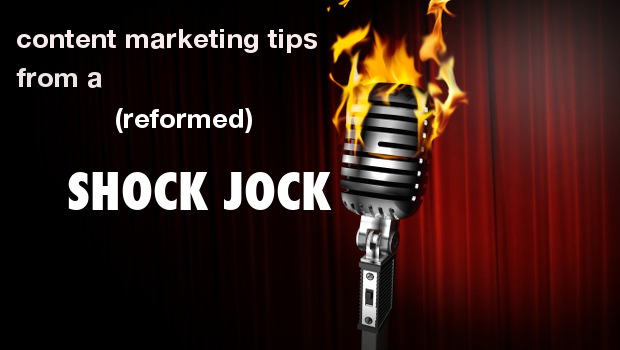
Content marketing for the Internet and content marketing for radio follow the same rules. I know this because before I wore the uniform of a plain black t-shirt and jeans of an Internet marketer, you found me in a Hawaiian shirt as a whacky morning radio shock jock. Every morning for 6 years I got up and put on a show containing 4 hours worth of content. I couldn’t “be quiet” or have nothing to say, and every word mattered. I loved my job, got excellent ratings, and thought that like Stefan Urquelle and Laura from Family Matters, radio and I were a love that would last forever. Then the Internet took over and made radio as relevant as a silent movie. I was one of the fortunate ones that recognized the Internet’s potential early on and knew audiences and money would flock to this channel like the salmon of Capistrano. I began learning everything I could about the digital space and eventually made the switch full time to digital marketing and founded my agency nerds do it better. However, the lessons and techniques I learned on air continue to directly translate to my content online so I share with you. 3 content marketing tips from a (reformed) shock jock:
1. Get to the point –On radio we knew the next station was just a click away, and this caused listeners to adopt a behavior of changing stations faster than Taylor Swift changes boyfriends. To combat this behavior we instituted a technique known as the inverted pyramid to get to the point immediately. The premise of the inverted pyramid is to always get to the most important point/best joke first and this “hooks” your audience. The audience hears this interesting or funny piece and they continue to stay throughout the bit assuming they will hear something else funny or interesting. Content online should follow the same advice and try to use the inverted pyramid.
This behavior of switching is even worse on the Internet because– your audience is busy. On the Internet people constantly click and are constantly distracted. Facebook updates, new versions of the Harlem Shake, and new Dragon Ball meme’s all fight for your audience’s attention. If you think that your audience follows your story as you build up to the point – than you will look back and see less people got to your point than finished Russell Crowe’s Les Miserables (if you sat through this entire piece of garbage than you deserve a medal). Get to the point within the first sentence if you can, but if not the first sentence, make sure it is in in the first paragraph.
2. Know your audience – Know your audience like Facebook knows its user base – unnervingly well. I learned this lesson in radio the hard way. I moved from Boston to Santa Barbara and was the sports reporter at a local station. During my initial reports I kept reporting on the Red Sox because that is what I cared about. However, I realized I was getting little feedback until I started reporting on the Dodgers and the Giants because that is what my audience cares about. The more I got to know my audience the better I was at catering to their needs. Knowing your audience is a constant in content. Make sure they get your references, that you understand their motivations, and that they care about what you are talking about. After all you are creating the content for them, not you.
3. Take a stance -As Jim Rome says you need to “have a take”. Even years ago the information people wanted was available and the audience received it from a variety of sources. As an example my radio audience could read the box sports score anywhere, what made the show successful was my views and my stance. Similarly the reason people are reading your content is because you wrote it. Take a stance on an issue and have a view. You do not have to be controversial, but you do need a stance. This is a win-win situation. If people agree with your stance, they share the article and say this is great/funny/right on. If they disagree with your view, they will also share the article say they disagree. Either way the article is gaining traction. Remember disagreements are not necessarily a bad thing and can open a great dialogue. There is only type of article that is not shared – a boring article.




